What Size Socket is a Water Heater Element: 8 Standard Sizes Revealed
If you are faced with the need to service your water heater and you have a question about what size socket is a water heater element, you have come to the right place! Selecting the right device is critical for proper, smooth, and most importantly safe operation.
Keep reading and I’ll take you through the 3 main types of sockets, their different sizes, and walk you through 8 water heater companies to make it easier for you to find and measure. I’ll also share my personal experience on how to identify the type of socket. Let’s not waste any time and get started!
Table of Contents
Working Principle Of A Water Heater Element
The functioning of your heater depends fully on the elements inside it.
- Your water heater element is connected to a set of wires with an electrical supply.
- It is an essential part that converts the electrical energy it receives into heat energy.
- The electrical energy is responsible for the hot water produced in the water tank.
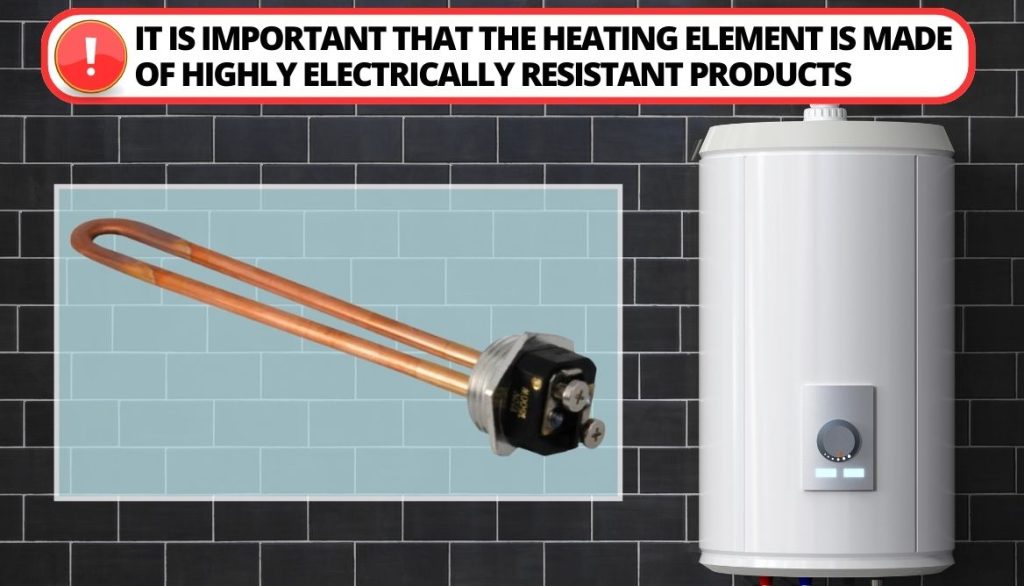
Note: The material used for the element is usually made of highly electrical-resistant products like nickel-chromium alloy, commonly known as Nichrome, to avoid casualties while in use.
How Does the Water Heat Up in the Water Tank?
The following points explain the process it takes for water to heat up in the tank:
- The heater element is usually submerged in the water tank.
- As the element heats up, the water it has close contact with also absorbs this heat and hereby transfers it to the surrounding water in the tank till the hot water temperature reaches the desired hotness.
- Most elements use a thermostat control unit to monitor the temperature of the water before it starts working.
- The thermostat unit sends a signal if there is a fall in water temperature and also does if there is a high temperature the heating element can turn off.
Note: The thermostat basically knows high and low temperatures based on the points of hot water temperatures set by the user before the operation of the heater.
Types Of Water Heater Elements
There are different types of water heater elements. Each type has specific features that can affect its durability and resistance to corrosion:
- The material used, such as zinc-plates steel, copper, stainless steel, etc;
- The part they consist of;
- The density of heating they produce;
- The installation required.
So let’s examine all types in detail!
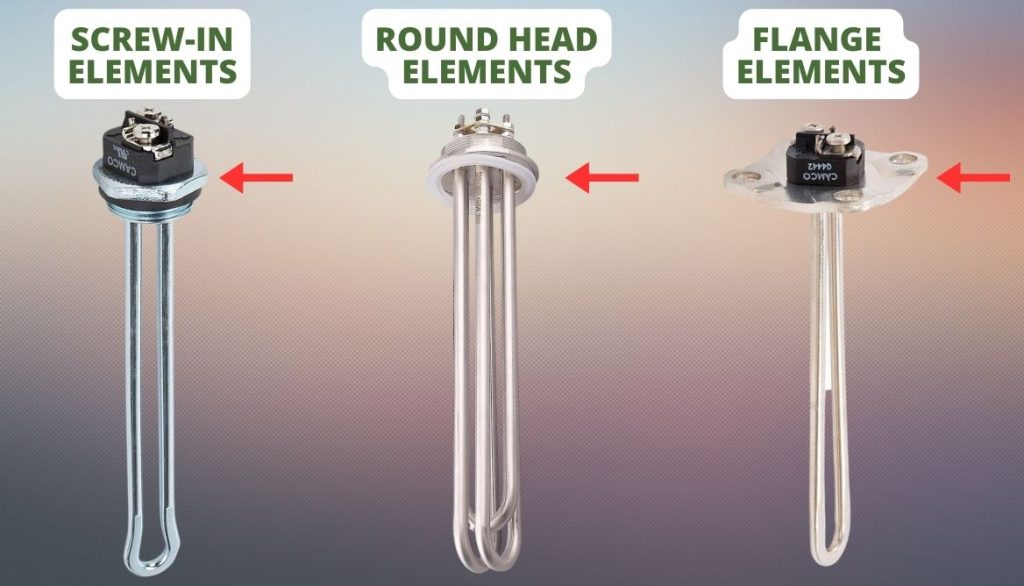
1. Screw-In Elements
This specific water heater element is the most common type, screw-in is available in varieties to accommodate different usage such as residential and industrial purposes.
- Parts: The element in Screw-in heaters are connected directly to the heater tank with screws.
- Material: Nickel-chromium or similar alloys are usually used in making Screw-in water heater elements.
- Density: They come in both low-density and high-density heating.
- Installation: Screw-in elements are usually easy to install and replace.
- Socket: These elements usually come in standard sizes of 1-1/2 inches (3.81 cm) which can be replaced with common tools.
2. Round Head Elements
These elements are typically designed for larger commercial or industrial uses and are less common compared to screw-in elements. They are also known as Bolt-in heating elements.
- Parts: These elements are secured to the water tank with bolts and gaskets.
- Material: They are also primarily made of nickel-chromium or similar alloys.
- Density: They can come in either low or high-density heating, depending on the one you bought.
- Installation: Installing bolt-in elements can be more complex due to their design and size. In most cases, they might require an expert to install them.
- Socket: The size for round head elements varies depending on the specific model and size, but they often require specialized tools for installation and replacement.
Note: Screw-in elements are threaded into the tank with screws, while bolt-in elements are secured with bolts and gaskets.
3. Flange Elements
Flange elements are commonly available in large commercial or industrial water heaters. Other features include;
- Parts: These elements have a flange or flat plate at one end, which is bolted or attached to the water heater tank wall.
- Material: Flange elements can be made from stainless steel, Incoloy sheath, zinc-plated steel, or copper, depending on the one you see. You can check product details before getting one.
- Density: These elements can be found in both low-density and high-density variants. The density depends on the design and wattage of the specific flange element.
- Installation: They are industrial heaters that may require professional installation because they have a high electric heating capacity.
- Socket: The socket size for flange elements can vary depending on the specific model and size of the element.
What Size Socket is a Water Heater Element: Is It Always The Same?
The water heater element socket size is not universal for all; they usually come in different sizes, typically based on the brand, type, and dimension.
Most elements are hexagonal in shape and are either 1-inch or 1-1/2-inch in diameter, so you will need a socket wrench with the correct size to fit the heater. The list below shows the most common sizes for elements:
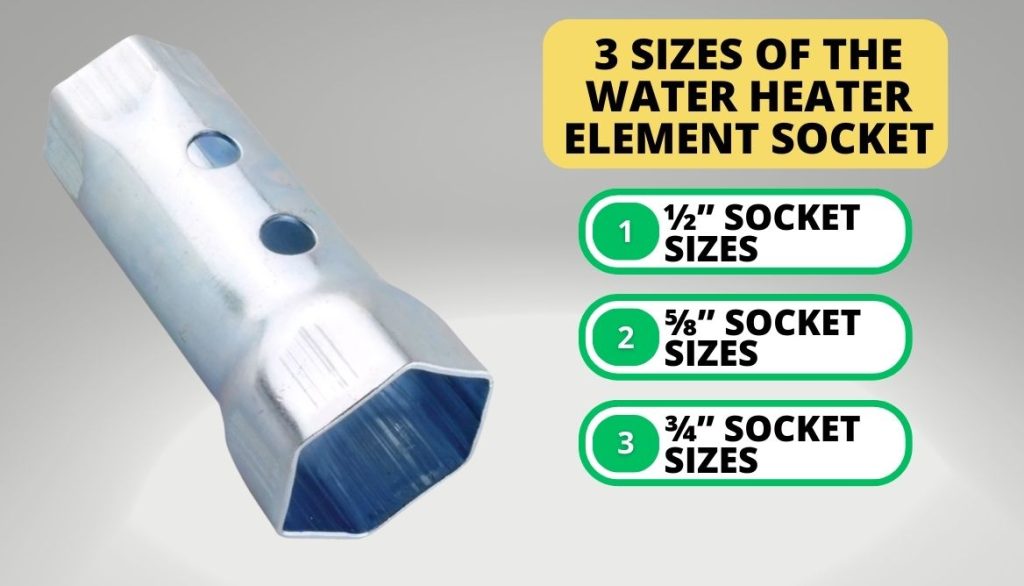
- ½” socket sizes;
- ⅝” socket sizes;
- ¾” socket sizes.
Standard Socket Size for Different Water Heaters: Rheem, Ecosmart, Bradford White and More
No matter the type of your water heater element, there will be a particular water heater element wrench or socket that will be a secure fit for it. Although there are some heaters that do not require a special one, the common socket sizes will do the job.
For your convenience, I have prepared below some common heater brands and their associated socket wrench sizes:
Brand | Socket Sizes |
Rheem Water Heater: | This common heater often requires a 1-1/2" socket for its elements while some specific models may require a 2-1/2" |
AO Smith Water Heater: | For the AO Smith water heater element, you'll typically need a 1-1/2" socket size |
Bradford White Water: | This brand uses also a 1-1/2" socket size |
EcoSmart Water Heater: | The correct socket size for EcoSmart is s also a 1-1/2 inch socket although there might be variations based on your model |
GE Water Heater: | GE often uses a 1-1/2" socket for water heater elements, similar to many other brands |
Whirlpool Water Heater: | Whirlpool also uses a 1-1/2" water heater element socket |
Bosch Water Heater: | This heater uses a 1-1/2" socket for its heating elements including the tankless models but it's essential to double-check your model for the correct socket size |
RV Water Heater: | RV water heaters also come in different water heater element sizes, but the common and right socket size is 1-1/2" for their heating elements |
Determining the Correct Socket Size for Your Water Heater Element
Picking the accurate socket size is important whenever you want to install or replace it. Using the wrong socket size can lead to damage and make the task more complex for you.,
Below, I will give you clues on how to determine the best size for your water heater element socket so you can easily and safely do the replacement task yourself.
1. Check the Owner’s Manual
The first step in knowing the standard size for your water heater element socket is to read the user manual that comes with it.
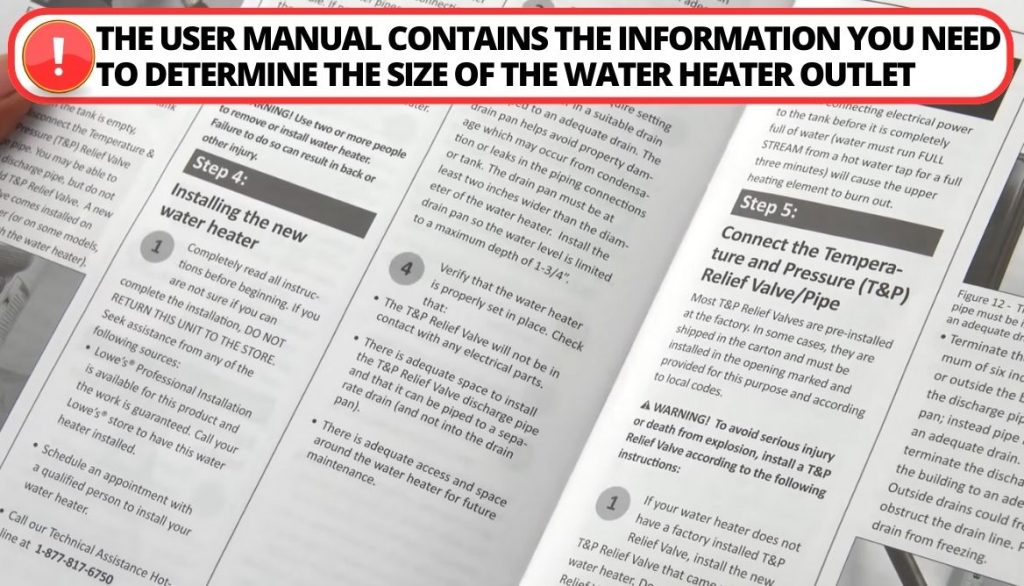
This document usually contains all necessary product information and specifications such as installation, replacement, and maintenance including:
- The correct socket size;
- Element type;
- Safety measures, etc.
2. Measure Your Heater Element Dimension
You can also measure your element dimension if you have misplaced your owner’s document or you can’t find the information in the manual.
Generally, the size of the nut or bolt head on the element is a good indicator of the size needed. So measure the width of the nut or bolt head with a measuring tape or calipers to determine the correct size socket required.
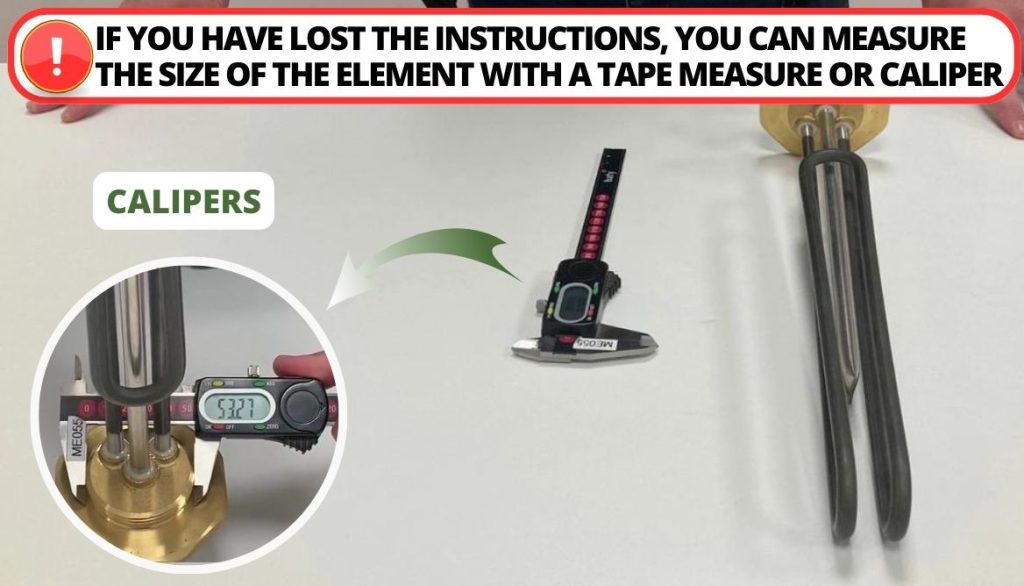
3. Research the Manufacturer’s Recommendations
If you have used the two methods above and you still didn’t get the socket size. Then you will need to search online for the correct standard socket size for your heater.
- Most brands usually have a website where they specify their product information and documentation for their users.
- Peruse their website for a guide or you can use the customer support section to ask for the correct size socket for your heater.
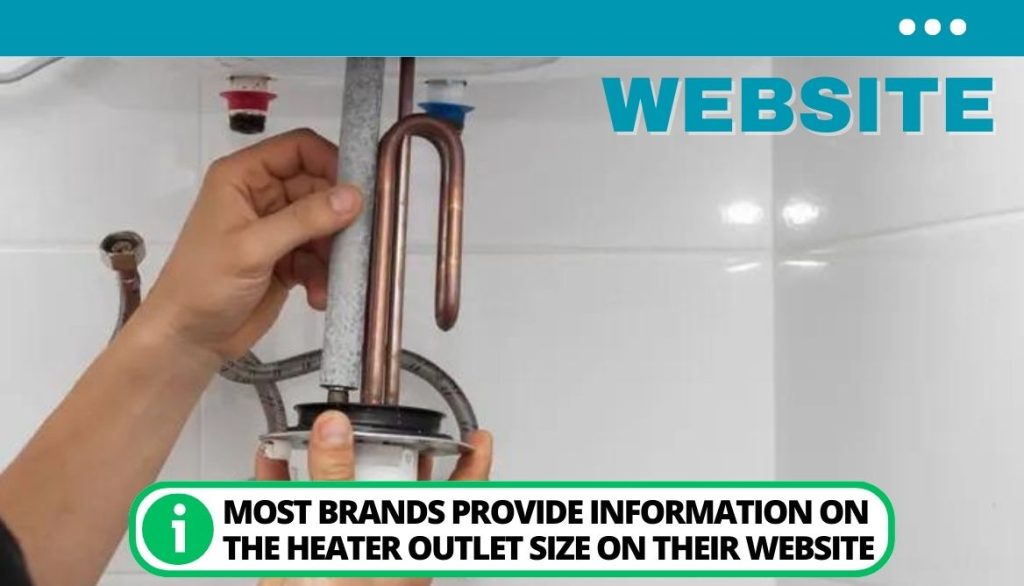
Important! Before you search online, make sure you know your heater brand, type, and model for proper information.
4. Go to the Hardware Store Near You Or Call for Expert
If you are not so good at searching for information online, another option you can utilize is to take the carton or snap a picture of your heater.
- Then take it to a nearby Hardware sales store so they can help you out in choosing the correct size and the necessary other tools.
- You can also ask for experts or professionals at the store as they usually have them around. So they can help you fix any issue you have with your heater element to avoid stress and ensure safety.
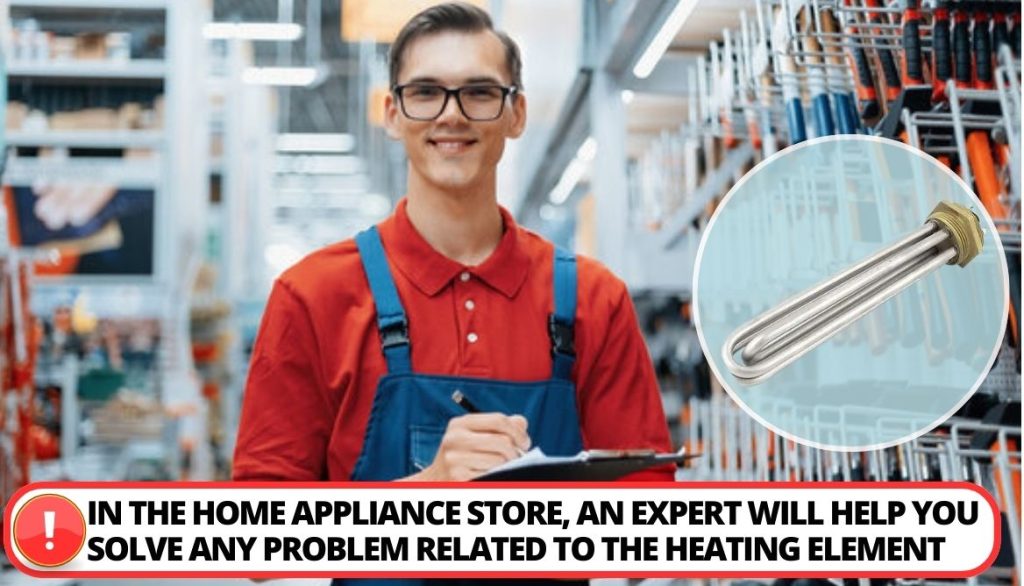
Note: It is important to shut off your appliance from the power supply and the cold water connection before you perform any task such as inspecting, measuring, replacing, etc.
Essential Tools Needed for Changing Water Heater Element
One of the ways to maintain and increase the efficiency of your heater is to replace the element in it whenever the need arises.
Before you can perform this task, you will need the following in your toolbox irrespective of the socket size of your element. Let’s use the table below to explain why you need these right tools!
Tools needed | Uses |
Safety Gear: | To protect your eyes and hands from potential hazards |
Water heater element Wrench: | For fastening and loosening element nuts and bolts |
Socket: | To turn or fasten the hexagonal edges |
Screwdriver: | To loosen and tighten screws |
Multimeter: | For checking for electrical continuity and voltage to ensure safety |
Teflon Tape: | To seal the threads of the new heating element before installation to prevent leaks |
Pipe or Plumbing Tape: | To secure the water line connections when reassembling the heater |
Rags: | To wipe up any spills or drips from the tank |
A Bucket or Drain Pan: | To collect any residual water that may drain out during replacement |
New Element: | For Replacement |
User Manual or manufacturer's instructions: | For guidance specific to your model |
Drain Valve: | To drain excess water from the tank |
FAQs
Why is Choosing the Correct Socket Important?
Selecting the correct socket size ensures proper and safe operation of the water heater. If the heating element is incorrectly sized, the appliance may not work or may cause a short circuit.
What tools do you need to change a hot water heater element?
For you to change your water heater element, you need a socket, element wrench, measuring tape screwdriver, rags, etc.
What size socket do you need for a water heater anode?
You need a 6-point 1-1/16-inch size to change your water heater anode.
What size is a hot water element wrench?
There are different wrench sizes for hot water heater elements, but the most common ones range from 1-1/2 inches to 2-1/2 inches.
To determine the exact size of the wrench you need, you should consult the user manual for your water heater or heating element, or check the manufacturer’s specifications online.
Is it safe to run the water heater from a 13A socket?
Using a 13A socket is not safe because your heater typically requires a higher electrical load than what a standard 13-amp socket can provide. Using it may lead to short circuit conditions due to overheating of wires which may hinder your heater performance, electric shock, or fire hazard.
Conclusion
Water heater elements play a crucial role in the overall functioning of your water heater. But the most important thing to know when using it choose the correct standard size socket for the water heater for more efficiency.
While there are different types of socket sizes, the most common socket size that works best for most water heaters is the 1-1/2″ socket. Make sure you check your product’s manual to ascertain the specific socket that works best for yours if the universal one does not work.
What socket size does your water heater element use? Let me know in the comment section. Thanks for reading.
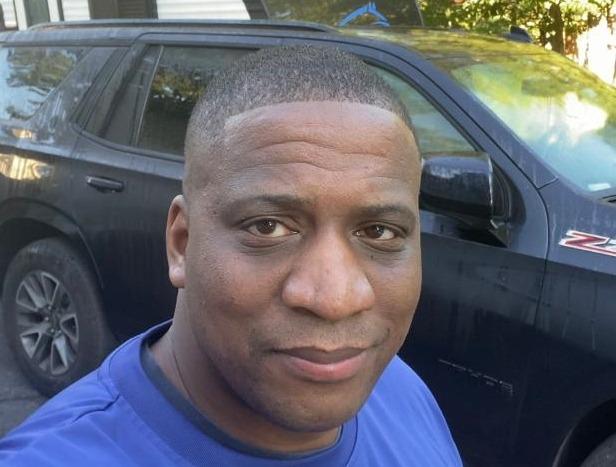
I`m a current Law Enforcement Officer working within the Counterterrorism Bureau in New York State. I have been Camping for over 20 years. My styles of camping include tent, car, truck, van, and RV travel trailer. I have a YouTube channel where I teach all types of camping with an entertaining method: https://youtube.com/@TheSmallsRVAdventures






